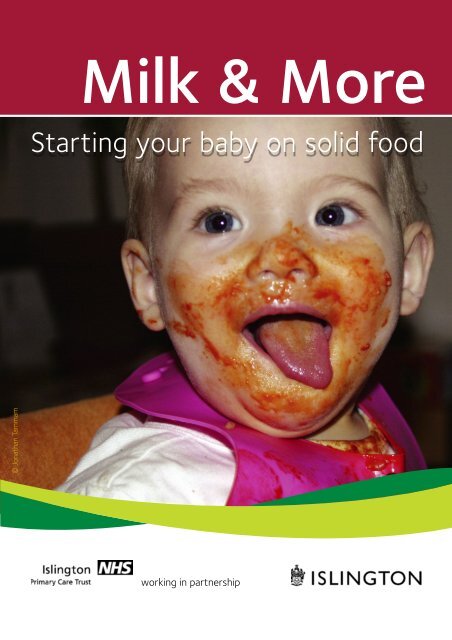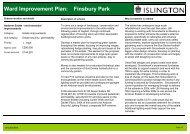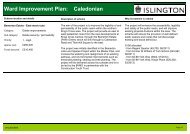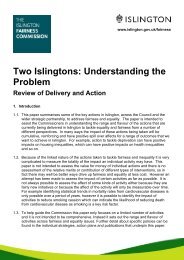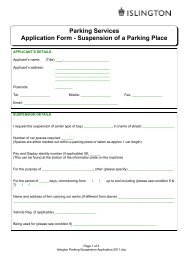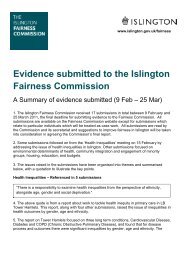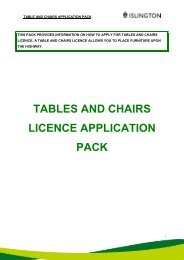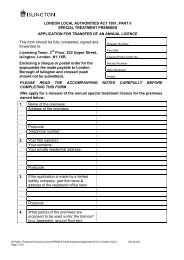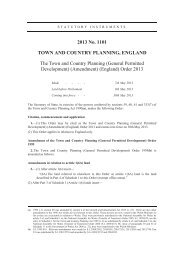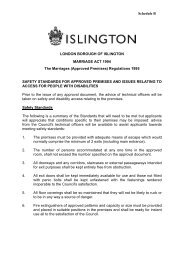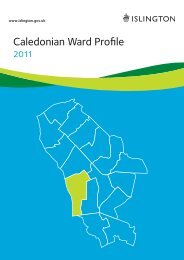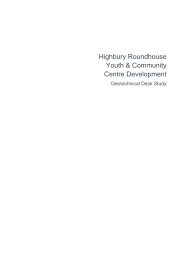Milk & More
Milk & More
Milk & More
Create successful ePaper yourself
Turn your PDF publications into a flip-book with our unique Google optimized e-Paper software.
<strong>Milk</strong> & <strong>More</strong><br />
Starting your baby on solid food<br />
© Jonathan Tammam<br />
working in partnership
This leaflet sets out the latest guidance, based on research, for<br />
weaning babies. It gives information on when to change babies'<br />
diets from having only milk to also eating some solid food and<br />
how to do this. It also gives the reasons behind the<br />
recommendations, based on the child's development.<br />
Starting babies on solid foods should begin:<br />
when their nutritional needs are no longer met completely in breast<br />
or formula milk - they need other foods and fluids to provide extra<br />
nutrients to meet their body's needs, though milk continues to be a vital<br />
source of nutrients. The World Health Organisation encourages mothers<br />
to continue breastfeeding for 2 years or longer, along with other foods,<br />
as breastmilk continues to provide significant nutrients and protection<br />
against illness. The benefits of breastfeeding are greater the longer you<br />
breastfeed, for both babies and mothers<br />
when the development of their body and skills means that they can<br />
cope well with such foods, and are eager to try them, without risking<br />
any harm<br />
<strong>Milk</strong> & <strong>More</strong> • June 2008
These two things usually happen around 6<br />
months when the baby accepts new tastes and<br />
textures easily. Delaying much beyond this age<br />
can lead to future problems, such as fussy<br />
eating. Giving solids too early, though, can make<br />
children more likely to become overweight.<br />
It is quite common for babies of this age to be waking<br />
during the night: giving solid food too early does not help this. All children<br />
are different and will progress at their own pace through the weaning period.<br />
The amount they eat will vary from child to child and from day to day. Don't<br />
worry if your child does not eat a lot one day - it is more important how it<br />
balances out over a week.<br />
We hope you find these guidelines useful. If you have any questions, please<br />
talk to your health visitor, community nursery nurse or a member of staff at<br />
the local children's centre.<br />
This document complements the<br />
Department of Health weaning leaflets. It<br />
was developed in Islington by representatives<br />
of the health visiting, dietetics and children's<br />
centre services in June 2008.<br />
<strong>Milk</strong> & <strong>More</strong> • June 2008
Principles of weaning<br />
1. Start introducing new foods<br />
and fluids, as well as breastmilk<br />
or formula, when your child is 6<br />
months old. There are many<br />
reasons to wait until this time:<br />
a) Breastmilk is the best source<br />
of the nutrients a baby needs<br />
for good growth and development,<br />
especially brain development.<br />
Giving anything other than<br />
breastmilk, or formula if you are<br />
not breastfeeding, before 6<br />
months means the baby may<br />
not take enough milk to meet<br />
his or her needs.<br />
b) Babies' digestive systems<br />
and kidneys are not mature<br />
enough to cope with other<br />
foods until 6 months. Giving<br />
anything else may increase the<br />
risk of allergies and infections,<br />
like gastroenteritis.<br />
c) Before 6 months, babies are<br />
still learning the skills they need<br />
to eat solid food. At 6 months,<br />
they are eager to try new foods<br />
and are able to reach out and pick<br />
up foods to feed themselves.<br />
d) At 6 months, your baby's<br />
tongue will be able to move foods<br />
around the mouth. He or she is<br />
also less likely to gag or choke.<br />
e) A baby who starts taking other<br />
foods and fluids at this age does<br />
not need food pureed and can<br />
manage family foods straightaway.<br />
2. Start by offering one meal a<br />
day and build up, so that by 1<br />
year your baby is having 3 meals<br />
and 2 healthy snacks. Babies<br />
have high nutrient needs but<br />
small stomachs, so need to eat<br />
frequently. Offer different<br />
tastes and textures.<br />
3. Allow babies to take food in<br />
their hands and feed themselves.<br />
This can be messy but helps<br />
them to learn essential skills.<br />
You can also offer soft foods on<br />
a spoon. Food can be mashed<br />
or cut up at first, if you choose,<br />
but it is important to increase<br />
the lumpiness quickly, so that<br />
by 12 months your baby is<br />
taking normal family foods.<br />
Freshly prepared and homecooked<br />
food is best for babies.<br />
4. It is important for meals to<br />
contain all the nutrients a baby<br />
needs. No one type of food has<br />
all the nutrients. Meals need to<br />
be made up of a range of<br />
different foods including<br />
starchy foods, protein foods<br />
and fruit and vegetables (see<br />
the tables for more<br />
information). You can use herbs<br />
and spices, but make sure they<br />
are not too strong. Do not add<br />
salt or sugar when cooking or<br />
afterwards, or use salty or<br />
sugary foods or fluids, as these<br />
can cause problems. Check<br />
ingredients on food labels for<br />
<strong>Milk</strong> & <strong>More</strong> • June 2008
added sugar. Do not give low<br />
fat milk or foods - babies need<br />
all the nutrients in full-fat milk.<br />
Semi-skimmed milk should not<br />
be used as a drink until the child<br />
is 2 years, and skimmed milk<br />
not until 5 years.<br />
5. Babies' stomachs are about the<br />
same size as their fists, which<br />
helps guide what size portions<br />
to give. Giving lots of bulky<br />
food (like very high fibre foods)<br />
can fill a baby's stomach but<br />
provides few nutrients.<br />
6. The Department of Health<br />
recommends daily vitamin drops<br />
(Vitamins A, C & D) for babies<br />
between 6 and 12 months who<br />
are breastfed or take less than<br />
500ml of formula a day, and for<br />
all children between 1 and 5<br />
years. This is because of an<br />
increasing incidence of rickets<br />
and other vitamin deficiencies<br />
in the UK. Families eligible for<br />
Healthy Start can obtain these<br />
drops free.<br />
7. For breastfed babies, as your<br />
baby takes more solids, continue<br />
to breastfeed on demand, as the<br />
baby will regulate their own<br />
intake. It is recommended for<br />
your baby to continue breastfeeding<br />
for 2 years or longer.<br />
Give any other fluids in a cup.<br />
8. If you are formula feeding, as<br />
your baby takes more solids,<br />
gradually reduce the amount of<br />
formula milk you give them to<br />
about 500-600 ml a day,<br />
either as a drink or in food.<br />
Having more than this means<br />
they will eat less food and miss<br />
out on essential nutrients. Start<br />
giving milk and fluids in a cup,<br />
rather than a bottle, as it is<br />
difficult to wean them off the<br />
bottle later and can affect their<br />
speech and dental health.<br />
9. Babies often react to new things<br />
by screwing up their face, or<br />
spitting new food out. Do not<br />
worry about this - just try again<br />
later. You may need to offer a<br />
new food 10-20 times before<br />
it is accepted.<br />
10. Healthy growth results from<br />
enough of the right kind of<br />
food; babies know when they<br />
have had enough. They show<br />
this by turning their head away,<br />
closing their mouth or pushing<br />
food away. Let them set the<br />
pace. Do not force or trick a<br />
baby to eat. If they do not want<br />
to eat, wait until the next<br />
mealtime. Do not give sweet or<br />
salty snacks in between to make<br />
up for what they did not have.<br />
11. Avoid distractions like TV and<br />
toys during mealtimes. Praise<br />
children when they eat well.<br />
They will often eat more when<br />
they eat at the same time as<br />
other family members.<br />
<strong>Milk</strong> & <strong>More</strong> • June 2008
From Birth<br />
Baby's development<br />
• Sucking<br />
• Rooting<br />
• Crying<br />
Digestive system &<br />
kidneys are immature<br />
but able to process<br />
breast milk<br />
Avoid<br />
What food/fluids<br />
<strong>Milk</strong>:<br />
• Breastmilk, on demand<br />
or, if not breastfeeding,<br />
• Formula - 2 1 ⁄2 fluid<br />
ounces per lb body<br />
weight in 24 hrs<br />
(150ml/kg)<br />
Formula-fed babies may<br />
need extra water in hot<br />
weather<br />
When and how to feed<br />
When hungry<br />
Hold the baby close to<br />
you and feed them using:<br />
• Breast<br />
• Bottle<br />
• Cup<br />
• All solid foods, as breastmilk, or formula milk if not breastfeeding, provides all a<br />
baby needs<br />
• All other fluids, if breastfed<br />
• Giving anything other than milk in a bottle<br />
• Adding food to milk<br />
<strong>Milk</strong> & <strong>More</strong> • June 2008
Around 4-5 months<br />
Baby's development<br />
During this time babies<br />
are learning skills that will<br />
enable them to start<br />
taking solids at 6 months<br />
• Sociable - aware of<br />
what others are doing<br />
• Starts to reach out for<br />
objects, including food<br />
• Watches others eat<br />
• Can hold head up<br />
• Munching movements<br />
• May have growth<br />
spurts when they<br />
seem hungrier and will<br />
feed more often for a<br />
few days to boost milk<br />
supply (or need some<br />
extra feeds if formula<br />
fed)<br />
What food/fluids<br />
<strong>Milk</strong>:<br />
• Breastmilk, on demand<br />
or, if not breastfeeding,<br />
• Formula - 2 1 ⁄2 fluid<br />
ounces per lb body<br />
weight in 24 hrs<br />
(150ml/kg)<br />
<strong>Milk</strong> is still the best source of<br />
all your baby needs for good<br />
growth and development,<br />
such as brain development.<br />
Giving anything else may<br />
mean your baby will not take<br />
enough milk. It may also<br />
harm your baby, as their<br />
body systems are not mature<br />
enough to cope with it.<br />
Waiting till 6 months also<br />
means your baby can move<br />
on quickly to family foods.<br />
There are also many foods<br />
you would have to avoid if<br />
you were to give anything at<br />
this age (such as fish, eggs,<br />
dairy products, wheat, liver,<br />
nuts and sesame).<br />
When and how to feed<br />
When hungry<br />
Hold the baby close to<br />
you and feed them using:<br />
• Breast<br />
• Bottle<br />
• Cup<br />
Avoid<br />
• All solid foods as breastmilk, or formula milk if you are not breastfeeding, provides<br />
all a baby needs<br />
• All other fluids, if breastfed<br />
• Giving anything other than milk in a bottle<br />
• Adding food to milk<br />
<strong>Milk</strong> & <strong>More</strong> • June 2008
6 -12 months - ready for solid foods<br />
Baby's development<br />
• Wants to do what others are doing<br />
• Can sit up with support<br />
• Able to reach out and hold<br />
small objects<br />
• Takes objects to mouth and chews<br />
on them<br />
• Tongue can move food around mouth<br />
• Reflex causing the baby to gag moves<br />
further back in mouth<br />
• Able to eat food off a spoon and start<br />
to drink from a cup<br />
• Able to cope with lumpier foods<br />
• Needs extra nutrients, like iron, from<br />
solid foods as well as milk<br />
• Has a small stomach so needs to<br />
eat frequently<br />
• Can react to new foods by screwing up<br />
face and spitting out<br />
• Indicates “No” or “Enough” - may close<br />
mouth, push food away or turn<br />
face away<br />
What food/fluids<br />
<strong>Milk</strong>:<br />
• Breastfeed on demand - babies will<br />
regulate their own intake<br />
• or, if not breastfeeding, gradually<br />
reduce formula milk intake as solids are<br />
introduced, to 500 -600ml per day - as<br />
drink or in food<br />
Offer meals & snacks containing:<br />
• raw or softly cooked fruit (e.g. pear)<br />
or vegetables - starting once a day<br />
and increasing gradually to 4 times a<br />
day by 1 year<br />
• starchy foods (e.g. bread, chapati,<br />
pasta, rice cereal, potatoes) - starting<br />
once a day and gradually increasing to<br />
4 times a day by 1 year<br />
• meat, chicken, fish, eggs, beans &<br />
pulses like lentils (dhal) and peas, dairy<br />
products like cheese, yoghurt, fromage<br />
frais, custard - give at least once per<br />
day if animal protein, twice a day if<br />
non-animal protein<br />
Vitamin drops, if breastfed or taking less<br />
than 500ml formula. (See principles for<br />
more details.)<br />
Tap water - use an open cup, or a free-flow<br />
cup without a valve, preferably with 2<br />
handles. This helps the baby learn to sip and<br />
is better for your baby's teeth.<br />
• Body systems mature enough to take<br />
solid food<br />
<strong>Milk</strong> & <strong>More</strong> • June 2008
When and how to feed<br />
• Start with one meal a day and build up gradually. By 1 year offer 3 meals and 2<br />
healthy snacks. Examples of healthy snacks include: fresh fruit; raw vegetables;<br />
cheese cubes; plain yoghurt with added fruit; bread, chapati or rice cake with paste,<br />
banana, mashed sardines or hummus; breakfast cereal with milk<br />
• Offer softly cooked and /or mashed foods on a spoon. Work towards increasingly<br />
lumpy foods. By 12 months babies should take normal family foods.<br />
• Give finger foods to pick up in hands to eat - be prepared for messy eating while<br />
they learn these skills. These could include soft fruit, raw or softly cooked<br />
vegetables, rice cakes, bread.<br />
• Portions should be about the same size as the baby's fist<br />
• Sit babies up to eat so they can reach out for foods better & are less likely to choke<br />
• Stay with them as they eat to encourage them and make sure they do not choke<br />
• Offer solid food after a milk feed, or in the middle of one, if that works better<br />
• Use a cup to give milk or fluids.<br />
Avoid<br />
• Salt<br />
• Sugar<br />
• Whole nuts<br />
• Honey<br />
• Soft cooked egg<br />
• Juices, squash<br />
• Rice or soya “milks” & goats milk<br />
• Cow's milk as drink<br />
• Skimmed or semi-skimmed milk<br />
• Reduced calorie or low fat food<br />
• Salty or sugary foods like crisps,<br />
sweets, biscuits.<br />
• Excessive high fibre foods, which fill<br />
up babies' stomachs too quickly<br />
• Tea or coffee - these reduce iron<br />
absorption<br />
• Excessively spicy foods<br />
<strong>Milk</strong> & <strong>More</strong> • June 2008
1 year and onwards - taking family foods<br />
Baby's development<br />
• Able to feed<br />
themselves by hand<br />
and with a spoon<br />
• Can drink from a cup<br />
without spout<br />
• Able to sit and enjoy<br />
mealtimes with family<br />
members or carer<br />
What food/fluids<br />
Family foods of normal<br />
adult texture, in three meals<br />
and two snacks a day. Food<br />
may be cut up, if necessary<br />
- there is no need to puree<br />
or mash.<br />
<strong>Milk</strong>:<br />
• breastmilk, on demand<br />
• or if not breastfeeding,<br />
full-fat cow's milk - no<br />
more than 500-600ml/day<br />
(as drink or in food).<br />
Vitamin drops for all<br />
children 1-5 years<br />
Tap water<br />
When and how to feed<br />
• Always use a cup for<br />
drinks, not a bottle.<br />
Going to bed with a<br />
bottle will cause<br />
tooth decay<br />
• Water & milk are the<br />
best drinks, but if<br />
using fruit juice, dilute<br />
1 part juice to 10<br />
parts water to prevent<br />
tooth decay<br />
• Give drinks during or<br />
after meals so your<br />
baby's stomach is not<br />
full up with fluid before<br />
eating<br />
• If your baby is not<br />
breastfeeding and<br />
does not like drinking<br />
milk, give full-fat dairy<br />
products like yogurt,<br />
cheese or cheese<br />
sauce or milk puddings<br />
daily to ensure enough<br />
calcium<br />
Avoid<br />
• Semi-skimmed milk before 2 years of age<br />
• Skimmed milk before 5 years<br />
• Tea and coffee<br />
• Fizzy drinks, squash, Ribena, carton drinks<br />
• High salt or sugar foods like crisps, biscuits, sweets<br />
• Whole nuts<br />
• Excessively high fibre foods, e.g. bran<br />
<strong>Milk</strong> & <strong>More</strong> • June 2008
You will want to make sure that your child's diet contains enough iron, folate,<br />
and other vitamins and minerals. Here are some ideas about foods that<br />
contain these nutrients.<br />
Foods containing IRON & FOLATE needed for good body system<br />
function and carrying of oxygen in the blood. Choose a variety of these<br />
foods and eat them with Vitamin C rich foods to help iron absorption<br />
<br />
<br />
<br />
<br />
<br />
Breastmilk<br />
Fortified breakfast cereals<br />
Kidney and liver<br />
Meat, especially beef,<br />
lamb/mutton, goat. Also<br />
chicken and turkey<br />
Wholemeal bread/flour<br />
Sardines, pilchards & other<br />
oily fish<br />
Pulses e.g. lentils, chick peas,<br />
soya, beans<br />
Spinach, broccoli, spring greens,<br />
kale<br />
Dried apricots, raisins<br />
Parsnip, potatoes<br />
Foods containing other VITAMINS & MINERALS needed for good immunity<br />
and healthy skin, eyes, bones, teeth, muscles and nervous system<br />
Vitamin A: liver; orange-fleshed<br />
fruits/vegetables and dark green<br />
leafy vegetables e.g. carrots, squash,<br />
sweet potatoes, red peppers, spinach,<br />
mango, papaya, apricots, breastmilk<br />
Vitamin C: citrus fruits (orange,<br />
satsuma), blackcurrants, tinned<br />
guava, spring greens, spinach, brussel<br />
sprouts, green and red peppers,<br />
strawberries, mango, kiwi fruit<br />
Vitamin D: fortified breakfast<br />
cereals, oily fish, egg, liver. Spend<br />
time outside, as sunshine is<br />
necessary for providing Vitamin D.<br />
Zinc: liver, kidney, lean meat, corned<br />
beef, bacon & ham, oily fish, whole<br />
grain breakfast cereals, beans, lentils,<br />
ground peanuts (peanut butter) or<br />
sesame seeds (tahini), wholemeal<br />
bread, eggs, milk<br />
Calcium: green leafy vegetables,<br />
sardines & pilchards, cheese, tofu,<br />
breastmilk, milk, yogurt, sesame<br />
seed, ground almonds, figs, beans,<br />
lentils, dried fruit<br />
<strong>Milk</strong> & <strong>More</strong> • June 2008
Cambridge<br />
Education<br />
@Islington<br />
Photographs in this leaflet were taken at Rosedale Early Years Centre by Tessa<br />
Hallman and at Kate Greenaway Nursery School and Children's Centre by<br />
Lottie Davies.<br />
If you would like more copies of this leaflet, or copies in another language<br />
or large font please contact:<br />
Children’s Information Service<br />
Telephone: 020 7527 5959<br />
Email: cis@islington.gov.uk<br />
For further information please contact your local children's centre or<br />
health visitor<br />
This leaflet is also available in Turkish, Somali, Bengali, Arabic, Spanish,<br />
French and Albanian.


